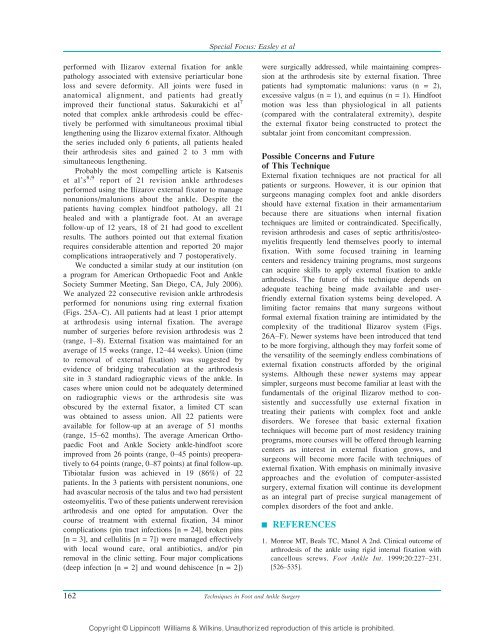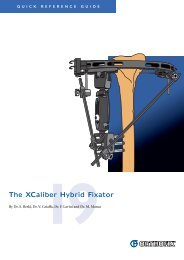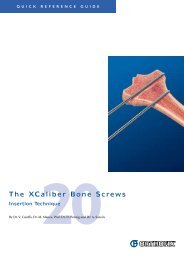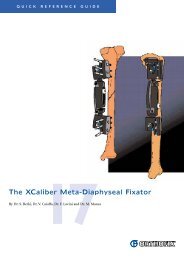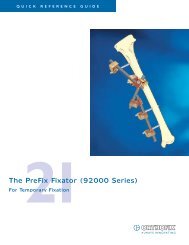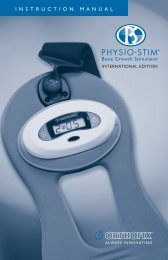Ankle Arthrodesis Using Ring External Fixation - Orthofix.com
Ankle Arthrodesis Using Ring External Fixation - Orthofix.com
Ankle Arthrodesis Using Ring External Fixation - Orthofix.com
You also want an ePaper? Increase the reach of your titles
YUMPU automatically turns print PDFs into web optimized ePapers that Google loves.
performed with Ilizarov external fixation for ankle<br />
pathology associated with extensive periarticular bone<br />
loss and severe deformity. All joints were fused in<br />
anatomical alignment, and patients had greatly<br />
improved their functional status. Sakurakichi et al 7<br />
noted that <strong>com</strong>plex ankle arthrodesis could be effectively<br />
be performed with simultaneous proximal tibial<br />
lengthening using the Ilizarov external fixator. Although<br />
the series included only 6 patients, all patients healed<br />
their arthrodesis sites and gained 2 to 3 mm with<br />
simultaneous lengthening.<br />
Probably the most <strong>com</strong>pelling article is Katsenis<br />
et al’s 8,9 report of 21 revision ankle arthrodeses<br />
performed using the Ilizarov external fixator to manage<br />
nonunions/malunions about the ankle. Despite the<br />
patients having <strong>com</strong>plex hindfoot pathology, all 21<br />
healed and with a plantigrade foot. At an average<br />
follow-up of 12 years, 18 of 21 had good to excellent<br />
results. The authors pointed out that external fixation<br />
requires considerable attention and reported 20 major<br />
<strong>com</strong>plications intraoperatively and 7 postoperatively.<br />
We conducted a similar study at our institution (on<br />
a program for American Orthopaedic Foot and <strong>Ankle</strong><br />
Society Summer Meeting, San Diego, CA, July 2006).<br />
We analyzed 22 consecutive revision ankle arthrodesis<br />
performed for nonunions using ring external fixation<br />
(Figs. 25AYC). All patients had at least 1 prior attempt<br />
at arthrodesis using internal fixation. The average<br />
number of surgeries before revision arthrodesis was 2<br />
(range, 1Y8). <strong>External</strong> fixation was maintained for an<br />
average of 15 weeks (range, 12Y44 weeks). Union (time<br />
to removal of external fixation) was suggested by<br />
evidence of bridging trabeculation at the arthrodesis<br />
site in 3 standard radiographic views of the ankle. In<br />
cases where union could not be adequately determined<br />
on radiographic views or the arthrodesis site was<br />
obscured by the external fixator, a limited CT scan<br />
was obtained to assess union. All 22 patients were<br />
available for follow-up at an average of 51 months<br />
(range, 15Y62 months). The average American Orthopaedic<br />
Foot and <strong>Ankle</strong> Society ankle-hindfoot score<br />
improved from 26 points (range, 0Y45 points) preoperatively<br />
to 64 points (range, 0Y87 points) at final follow-up.<br />
Tibiotalar fusion was achieved in 19 (86%) of 22<br />
patients. In the 3 patients with persistent nonunions, one<br />
had avascular necrosis of the talus and two had persistent<br />
osteomyelitis. Two of these patients underwent rerevision<br />
arthrodesis and one opted for amputation. Over the<br />
course of treatment with external fixation, 34 minor<br />
<strong>com</strong>plications (pin tract infections [n = 24], broken pins<br />
[n = 3], and cellulitis [n = 7]) were managed effectively<br />
with local wound care, oral antibiotics, and/or pin<br />
removal in the clinic setting. Four major <strong>com</strong>plications<br />
(deep infection [n = 2] and wound dehiscence [n = 2])<br />
162<br />
Special Focus: Easley et al<br />
were surgically addressed, while maintaining <strong>com</strong>pression<br />
at the arthrodesis site by external fixation. Three<br />
patients had symptomatic malunions: varus (n = 2),<br />
excessive valgus (n = 1), and equinus (n = 1). Hindfoot<br />
motion was less than physiological in all patients<br />
(<strong>com</strong>pared with the contralateral extremity), despite<br />
the external fixator being constructed to protect the<br />
subtalar joint from con<strong>com</strong>itant <strong>com</strong>pression.<br />
Possible Concerns and Future<br />
of This Technique<br />
<strong>External</strong> fixation techniques are not practical for all<br />
patients or surgeons. However, it is our opinion that<br />
surgeons managing <strong>com</strong>plex foot and ankle disorders<br />
should have external fixation in their armamentarium<br />
because there are situations when internal fixation<br />
techniques are limited or contraindicated. Specifically,<br />
revision arthrodesis and cases of septic arthritis/osteomyelitis<br />
frequently lend themselves poorly to internal<br />
fixation. With some focused training in learning<br />
centers and residency training programs, most surgeons<br />
can acquire skills to apply external fixation to ankle<br />
arthrodesis. The future of this technique depends on<br />
adequate teaching being made available and userfriendly<br />
external fixation systems being developed. A<br />
limiting factor remains that many surgeons without<br />
formal external fixation training are intimidated by the<br />
<strong>com</strong>plexity of the traditional Ilizarov system (Figs.<br />
26AYF). Newer systems have been introduced that tend<br />
to be more forgiving, although they may forfeit some of<br />
the versatility of the seemingly endless <strong>com</strong>binations of<br />
external fixation constructs afforded by the original<br />
systems. Although these newer systems may appear<br />
simpler, surgeons must be<strong>com</strong>e familiar at least with the<br />
fundamentals of the original Ilizarov method to consistently<br />
and successfully use external fixation in<br />
treating their patients with <strong>com</strong>plex foot and ankle<br />
disorders. We foresee that basic external fixation<br />
techniques will be<strong>com</strong>e part of most residency training<br />
programs, more courses will be offered through learning<br />
centers as interest in external fixation grows, and<br />
surgeons will be<strong>com</strong>e more facile with techniques of<br />
external fixation. With emphasis on minimally invasive<br />
approaches and the evolution of <strong>com</strong>puter-assisted<br />
surgery, external fixation will continue its development<br />
as an integral part of precise surgical management of<br />
<strong>com</strong>plex disorders of the foot and ankle.<br />
| REFERENCES<br />
Techniques in Foot and <strong>Ankle</strong> Surgery<br />
1. Monroe MT, Beals TC, Manol A 2nd. Clinical out<strong>com</strong>e of<br />
arthrodesis of the ankle using rigid internal fixation with<br />
cancellous screws. Foot <strong>Ankle</strong> Int. 1999;20:227Y231.<br />
[526Y535].<br />
Copyright © Lippincott Williams & Wilkins. Unauthorized reproduction of this article is prohibited.


